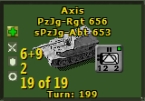ralphtricky
Posts: 6685
Joined: 7/27/2003
From: Colorado Springs
Status: offline

|
quote:
ORIGINAL: Grognard
quote:
Another question would be is the 'overstacking' necessary. I would think defense in depth would be better. What would other players do if facing a human opponent ?
Exactly; this illustrates the difference 'tween Elmer & us. Against Elmer I will overstack to get the odds under 2:1 because I know Elmer won't attack. Against a Hu-man - never, never, never - defense in depth is more tactically sound. Reversing the roles, I would certainly do a frontal assault against a red stack at less than 2:1 just to produce the excess casualties and I would expect any Hu-man opponent to do the same. Whereas if I see your defense in depth (even with > 2:1 odds for the initial attack), a possible counterattack would certainly give me pause in the example above.
Would it be possible to program Elmer with a chance variability in his attack routine? i.e. instead of Elmer just crunching numbers - if certain conditions are met (red stacks, objective hex, key terrain hex) give him a binary yes to attack where he normally wouldn't.
To what extent does Elmer currently recognize key terrain? Chokepoints, flank anchors, etc.
It might be possible to add some more stances (or tune the existing ones) so that Elmer will attack at < 1:1, the problem is that with combats taking a variable number of rounds, 1:1 odds are more likely to burn the whole turn, that's why he doesn't like low odds.
He doesn't recognize chokepoints or flank anchors, he's strictly objective based right now. He does recognize good defensive terrain and bad defensive terrain, and bridging engineers try to bridge rivers, but that's it for right now.
|
 Printable Version
Printable Version







 .) I understand why it's there, and how it can help, but it seems like it makes it harder for designers. The other option I might pursue is to treat the designer value as an override instead of a modifier if set to anything other than 'stand'.
.) I understand why it's there, and how it can help, but it seems like it makes it harder for designers. The other option I might pursue is to treat the designer value as an override instead of a modifier if set to anything other than 'stand'. 









 New Messages
New Messages No New Messages
No New Messages Hot Topic w/ New Messages
Hot Topic w/ New Messages Hot Topic w/o New Messages
Hot Topic w/o New Messages Locked w/ New Messages
Locked w/ New Messages Locked w/o New Messages
Locked w/o New Messages Post New Thread
Post New Thread